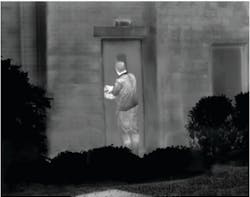Video: A Fresh Way to Integrate
When security is paramount, mission-critical facilities—such as power plants, pharmaceutical manufacturers or transportation infrastructure hubs—rely on the accuracy of detection systems to protect perimeters and access points. And the precision and versatility of thermal technology can supplement and strengthen existing security systems.
Thermal cameras detect and identify people based on their body heat. Infrared technology, the basis for thermal imaging, detects radiation at longer wavelengths than those of visible light, enabling an extensive list of applications—from astronomical observation to long-range surveillance, which is vitally important when securing a perimeter.
Tight perimeter security is not new. But like any industry, progress and continued success are defined by innovation. CCTV systems powered by video cameras generally have been perceived as crucial elements in securing a perimeter. But CCTV-exclusive systems have fundamental flaws that thermal technology integration can help rectify.
Lighting systems cost money, all night, every night
Possibly the most tangible benefits of integrating thermal technology into a security system are significantly increasing nighttime range and eliminating or reducing the need for exterior lighting systems.
CCTV systems heavily rely on powerful and expensive artificial lights installed at regular intervals around a facility’s perimeter. A video camera can only see as far as the light allows. If one lighting column shuts down for any reason, the perimeter is left with an area of extreme vulnerability.
To maintain the accuracy of video cameras in a traditional CCTV system, light fixtures may need to be installed as often as every 100 to 150 yards. Otherwise, the cameras’ faltering accuracy could leave blind areas throughout. In the past, the only solution would be to spend more money and install more cameras.
Thermal technology, however, is completely independent of lighting conditions – from the eerie glow of a full moon to the most opaque cloudy nights and starless skies.
Even a standard thermal camera is accurate at 400 to 600 yards, often more. As an added benefit, thermal imaging is not susceptible to changes in shadows and cannot be fooled by even the heaviest camouflage, which helps ensure accuracy at those longer ranges.
Long-range accuracy translates to cost savings by requiring fewer cameras for each column and less fiber optic and power cabling, as well as their associated ground works.
Blending innovation with tradition
But say you already have installed lighting, as you have long relied on CCTV systems. Thermal cameras can be fully integrated into an existing CCTV system to the point they complement one another and provide a substantial increase in the effectiveness of perimeter security.
Video content analysis (VCA) systems are being deployed more often to automatically detect intruders. VCA’s accuracy depends on the visual quality and contrast of its intruder identification. Thermal cameras’ ability to naturally highlight a person provides more reliable data, especially at night but also in some daytime conditions. Fully integrating thermal technology into the VCA system can improve detection accuracy, trigger alerts and automatically illuminate visible lighting. The integrated system also collects and reports incident data – supplementing existing VCA and creating a much more formidable security system.
Innovation has also eased the integration of dual systems. In the past, critics harped on the limited control of the thermal camera zoom function.
Today, however, some thermal cameras—such as Irisys’ IRI 6300—are equipped with continuous digital zoom that allows operators to transition seamlessly between visible and thermal while maintaining complete control of the viewing mechanism.
Efficient overhaul of a perimeter’s security merely scratches the surface of the potential applications of thermal technology. From evacuation management to tailgate detection at secure access points, thermal-powered cameras and sensors can add another layer to help ensure perimeters, and the facilities, capital, data, people and other assets within those perimeters, are not compromised.
